Attention Catboat Sailors
- Catboat sailors of all kinds can download and enjoy this Catboat Sailing Manual, filled with information about catboat sailing techniques and specifics about certain Com-Pac and Marshall catboats:
Catboat Sailing Manual in pdf format
Above, clockwise from top left:
1. Hardware for tack reef point: Ronstan cheek block and bolts, small SeaDog Clamcleat, small eye strap, screws
2. Hardware for outhaul: Harken micro block, small shackle, SeaDog Lite Clamcleat
3. Adjustable outhaul installed on boom
4. Hardware for lazy jacks: two Harken cheek blocks, two SeaDog clamcleats, and Harken stand up block on spring for downhaul
Sun Cat with spars and sail removed to change out hardware
Under sail, showing slack lazy jack line and slack tack reef line
Clew reefed
Tack reefed from starboard side showing clamcleat
Tack reefed overview
Cleat for clew reef, block for lazy jack, cleats for lazy jack and reef line
Tack unreefed
Sail partially raised showing lazy jacks holding main boom and constraining gaff boom and part of sail
Downhaul with sail fully lowered
Modifying my Sun Cat's Rigging
I decided that my Com-Pac Sun Cat could be made even easier and more fun to sail with a few modifications to how the sail is handled. The sail and gaff boom are much more controllable with lazy jacks, and the gaff boom gooseneck's tendency to stick in the mast slot was annoying to my wife, so I wanted to install a downhaul on that gooseneck.
Also, the outhaul on the main boom was not easily adjustable under sail, and the reefing system, while simple and traditional, left something to be desired when used singlehanded. After making some measurements and gathering all the needed hardware, I started drilling holes in spars.
Adding Lazy Jacks
For the lazy jacks, I ran a pair of lines from stainless eye straps near the top of the mast through a pair of Harken cheek mounted bullet blocks on either side of the boom, and then through a pair of SeaDog Clamcleat aluminum jam cleats.
It is easy with the Clamcleats to tighten the lazy jacks when needed, and when fully released they hang with just enough extra slack to allow the boom to come all the way down. They can exit the sail cover through the slot intended for the peak halyard when the sail is down and covered.
It's a single leg lazy jack, so does not contain the sail as well as a multiple leg system, but it gathers the bulk of the sail together, and more importantly, it constrains the tip of the gaff boom, which otherwise might whack you in the head on its way to dropping down and scratching the gelcoat or woodwork on the boat.
The lazy jacks allow you to lift the main boom prior to raising the sail, putting less load on the halyards, and allow you to relieve the weight of the boom from the sail to achieve better sail shape in light breezes. This technique combined with a boom vang would also stabilize the main boom against rocking in waves and allow the sail to better hold its shape.
All of the hardware I used was stainless and I bought a couple of new taps to make the threads in the mast and boom. The spars are thin enough in most places that it really works out to be little more than one thread.
Because of the mix of stainless steel and aluminum hardware and the aluminum mast and boom in a saltwater environment, I coated all the pieces with Tef-Gel as I put it together.
Creating A Gaff Boom Downhaul
I wanted to keep the gaff boom downhaul as simple as possible. I mounted a stand-up block near the base of the mast on the starboard side and ran a line from the gaff boom gooseneck down through the block and then just straight across the deck. The end is passed through one of the halyard cleats on the bulkhead and stop knotted.
It doesn't look particularly neat with that line lying across the deck, but it's handy when you're in position to handle the halyards, and that's all that counts.
A quick tug when the gaff gets stuck in the mast track, and down she comes. I think this was the best modification of all, since my wife seemed to like it best.
Improving the Reefing System
I was dissatisfied with the standard reefing arrangement on the Sun Cat because it requires a single handed sailor to be in two places at once. From the cockpit, you can control both halyards and you can take in the clew reef on the boom, but setting the tack reef cringle on the hook requires a trip to the mast. I wanted to be able to do that from the cockpit.
My solution was to install an eye strap on the port side of the boom as far forward as possible, and a cheek block on the starboard side, also mounted as far forward as possible. A line goes from the eye strap through the cringle and down to the cheek block, then aft along the boom to another SeaDog Clamcleat mounted on the boom.
My reefing procedure is now:
- Tighten lazy jacks to support boom above gallows.
- Release peak halyard Spinlock rope clutch and ease to level gaff boom.
- Release throat halyard and wish the throat would come down.
- Tug on the downhaul when it doesn't, bringing the throat down a little more than the distance from the tack to the reef cringle.
- Tighten tack reef line and jam in cleat.
- Tighten clew reef line and cleat on conventional cleat.
- Tension throat halyard against main boom downhaul at proper height.
- Tension peak halyard.
- Release lazy jacks.
I tried it out in nice, light conditions, reefing the sail and shaking out the reef several times. It works smoothly and produces a reasonable sail shape. I wish I could have figured out a way to mount the tack reef line even further forward, as it pulls straight down, but I could not.
Making an Adjustable Outhaul
The foot of the Sun Cat sail has a bolt rope, so adjustability of the shape of the sail is somewhat limited by being attached to the boom, but outhaul tension does make a difference in performance. The problem is, it doesn't make enough of a difference to make me get up there and untie the outhaul, adjust it, and retie it. Also, running the outhaul straight to the hole in the fitting on the end of the boom will chafe the line.
My solution was to add a small block on the end of the boom and yet another SeaDog Clamcleat. Now it is easy to reach up and adjust it then jam it back in place, and chafe on the line should be reduced quite a bit.
A note about jam cleats of all types:
I got the metal ones because jam cleats wear out, and I figure these will wear out more slowly. Even when new, they are not a very reliable attachment. The line can slip or be knocked free, and if jammed under a heavy load can be difficult to detach. I'm using them on this boat because they are small enough to fit on my small boom and they are cheap, quick, and easy to use. Installing the same kinds of modifications on a larger boat, I would use cam cleats or conventional cleats.
Whether using moving cams with teeth or jamming in a wedge, cleats that stop a line by pinching down on it are harder on the line than good old fashioned cleats. I'm willing to replace running rigging or swap it end-for-end more frequently for the convenience of jam cleats on the Sun Cat, which is why my boom now has four of them.
Attention Catboat Sailors
- Catboat sailors of all kinds can download and enjoy this Catboat Sailing Manual, filled with information about catboat sailing techniques and specifics about certain Com-Pac and Marshall catboats:
Catboat Sailing Manual in pdf format

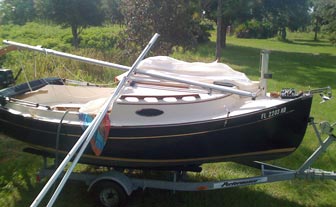
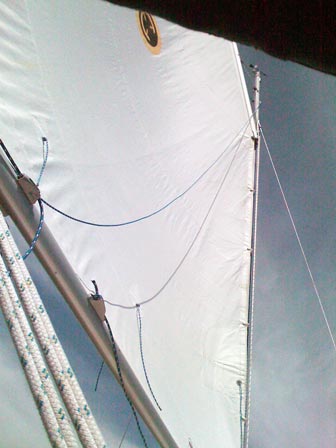
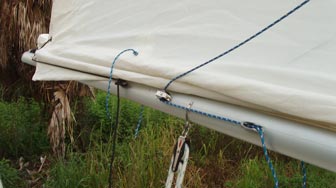
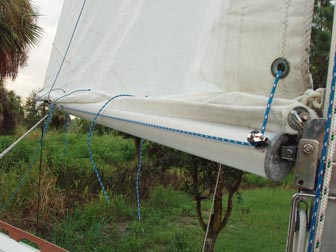
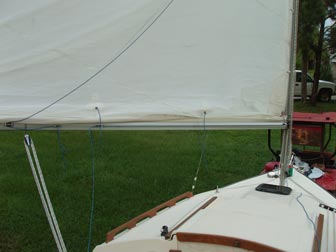
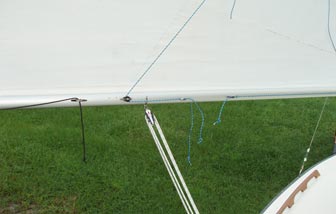
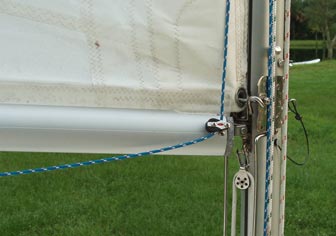
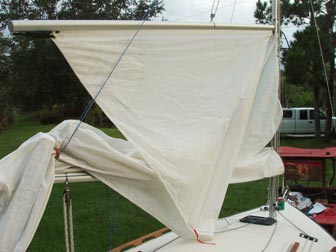
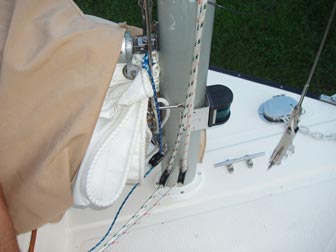
Leave a Reply
You must be logged in to post a comment.